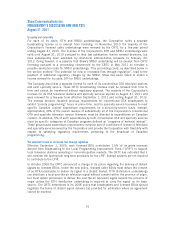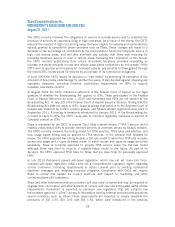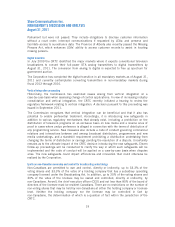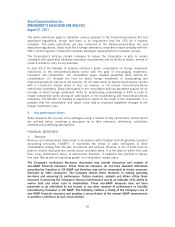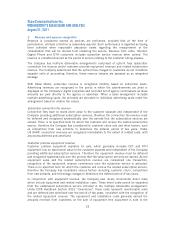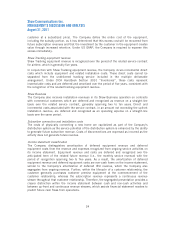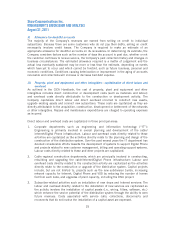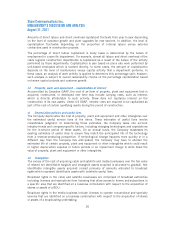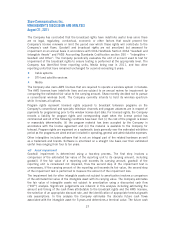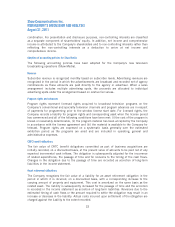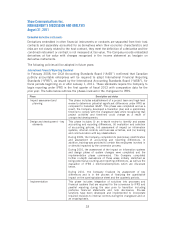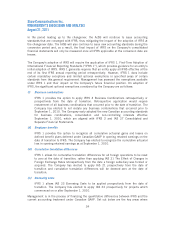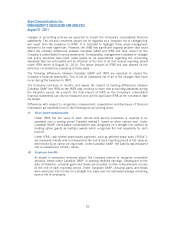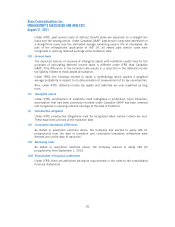Shaw 2011 Annual Report Download - page 30
Download and view the complete annual report
Please find page 30 of the 2011 Shaw annual report below. You can navigate through the pages in the report by either clicking on the pages listed below, or by using the keyword search tool below to find specific information within the annual report.Shaw Communications Inc.
MANAGEMENT’S DISCUSSION AND ANALYSIS
August 31, 2011
Amounts of direct labour and direct overhead capitalized fluctuate from year to year depending
on the level of customer growth and plant upgrades for new services. In addition, the level of
capitalization fluctuates depending on the proportion of internal labour versus external
contractors used in construction projects.
The percentage of direct labour capitalized in many cases is determined by the nature of
employment in a specific department. For example, almost all labour and direct overhead of the
cable regional construction departments is capitalized as a result of the nature of the activity
performed by those departments. Capitalization is also based on piece rate work performed by
unit-based employees which is tracked directly. In some cases, the amount of capitalization
depends on the level of maintenance versus capital activity that a department performs. In
these cases, an analysis of work activity is applied to determine this percentage split; however,
such analysis is subject to overall reasonability checks on the percentage capitalization based
on known capital projects and customer growth.
iv) Property, plant and equipment – capitalization of interest
As permitted by Canadian GAAP, the cost of an item of property, plant and equipment that is
acquired, constructed, or developed over time may include carrying costs, such as interest,
which is directly attributable to such activity. Shaw does not capitalize interest on the
construction of its own assets. Under US GAAP, interest costs are required to be capitalized as
part of the cost of certain qualifying assets during the period of construction.
v) Depreciation policies and useful lives
The Company depreciates the cost of property, plant and equipment and other intangibles over
the estimated useful service lives of the items. These estimates of useful lives involve
considerable judgment. In determining these estimates, the Company takes into account
industry trends and company-specific factors, including changing technologies and expectations
for the in-service period of these assets. On an annual basis, the Company reassesses its
existing estimates of useful lives to ensure they match the anticipated life of the technology
from a revenue-producing perspective. If technological change happens more quickly or in a
different way than the Company has anticipated, the Company may have to shorten the
estimated life of certain property, plant and equipment or other intangibles which could result
in higher depreciation expense in future periods or an impairment charge to write down the
value of property, plant and equipment or other intangibles.
vi) Intangibles
The excess of the cost of acquiring cable and satellite and media businesses over the fair value
of related net identifiable tangible and intangible assets acquired is allocated to goodwill. Net
identifiable intangible assets acquired consist primarily of amounts allocated to broadcast
rights which represent identifiable assets with indefinite useful lives.
Broadcast rights in the cable and satellite businesses are comprised of broadcast authorities
including licenses and exemptions from licensing that allow access to homes and subscribers in
a specific area that are identified on a business combination with respect to the acquisition of
shares or assets of a BDU.
Broadcast rights in the media business include licenses to operate conventional and specialty
services that are identified on a business combination with respect to the acquisition of shares
or assets of a broadcasting undertaking.
26


